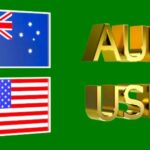EURUSD fails to capitalise on this week’s small rebound from a multi-month low.
The EURUSD pair attracts some sellers near the 1.0800 level. Or the 100-day Simple Moving Average (SMA). And remains on the defensive during the first half of the European session on Friday. Spot prices appear to have snapped a three-day winning streak. Stalling the ongoing recovery from a multi month low reached earlier this week. The downside, however, is still buffered in the Following recent hawkish remarks. From numerous European Central Bank (ECB) officials and restrained US Dollar (USD) market action.
The USD extends its moderate range-bound price action, providing support for the pair.
Furthermore, traders appear hesitant to make aggressive directional bets. And want additional information about the Federal Reserve’s (Fed) rate hike path. A bevy of senior FOMC members recently pushed back against market predictions for early and substantial rate reduction in 2024, citing the US economy’s continued resilience. This is still supportive of higher US bond yields. However, the markets are still pricing in five rate cuts over the next seven FOMC policy meetings this year, which serves as a negative for the USD and supports the EURUSD pair.
Meanwhile, the market focus will stay fixed on the release. The newest US consumer inflation numbers, which are anticipated next week, may provide some clues regarding the likely timing and speed of Fed rate decreases. This, in turn, will have a significant impact on the near-term USD price dynamics and provide some traction to the EURUSD pair.
Bets that the European Central Bank would begin cutting interest rates in April limit the common currency’s upside.
Officials at the European Central Bank have been working hard to moderate market expectations for early interest rate cuts and provide some support for the EURUSD pair in the face of weak US Dollar demand.
Governing Council member Pierre Wunsch stated on Thursday that he would prefer to wait for additional wage data, which is inconsistent with the 2% inflation target, before choosing to decrease interest rates.
This follows comments made by ECB board member Isabel Schnabel on Wednesday, who stated that the central bank must be prudent when decreasing interest rates because inflation could flare up again.
Furthermore, the ECB’s most recent economic report suggested that interest rate policy is unlikely to change before June, despite the grim forecast that the Eurozone economy will likely fall in Q4.
Expectations for an ECB interest rate cut at the start of the second quarter have grown stronger, discouraging traders from placing big optimistic bets on the shared currency.
Data released on Thursday revealed that US Initial Jobless Claims declined to 218K last week. Indicating a strong labor market and supporting forecasts. That the Federal Reserve will Maintain higher interest rates for an extended period of time.
The uncertainty surrounding the Fed’s rate cut path does not provide any substantial impetus to the US Dollar. Which stays below a multi month low and continues to operate as a tailwind for the currency pair.









